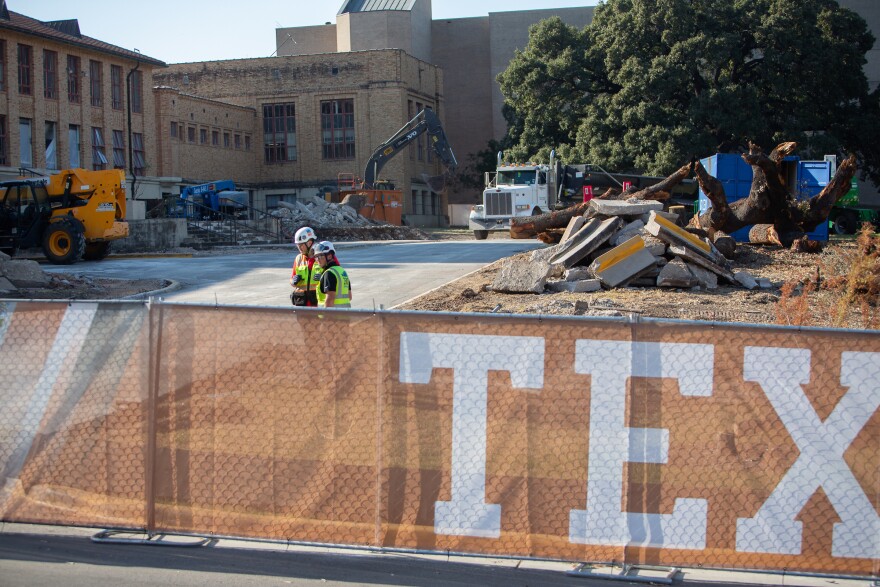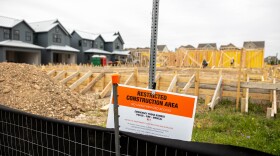Lee esta historia en español aquí
The process of demolishing the building that housed the first integrated middle school in Austin started last month despite efforts from preservation advocates to stop it.
UT got a permit from the Texas Historical Commission to tear down the Steve Hicks School of Social Work and build a $70 million football training facility in its place. The building formerly housed University Junior High.
UT and the City of Austin created University Junior High in the 1930s to give university students a place to practice teaching and to meet the city's growing population. It integrated in 1957 after the Allan Junior High building burned down, and the Hispanic students needed a place to go. The building sat in the middle of a diverse community, so the integration was considered natural. Before it shut down 10 years later, the student body was predominately made up of students of color.
"The historic value of the building was not valuable to UT. It was more valuable to put something there that was going to benefit just the athletes."Kathleen Armenta, cofounder of the save the past for the fUTure coalition
The School of Social Work adopted the building in 1994, and artist Raúl Valdez painted a mural depicting social issues in the stairwell shortly after.
The new facility aims to cut the walk time between Darrell K Royal-Texas Memorial Stadium and the athletes' current practice facility, Athletics Director Chris Del Conte announced in February. Students in the social work school will move closer to the center of campus, Brent Stringfellow, associate vice president for campus operations, wrote in the permit application.
Austinites and members of the UT community formed the save the past for the fUTure coalition to fight to preserve the building by getting it historical protection through the Texas Historical Commission. The commission named the building a State Antiquities Landmark on July 27.
The designation requires a property owner to get commission approval before demolishing a building, said Chris Florance, the communications director for the commission. He said it does not fully protect the building from demolition, however.
Kathleen Armenta, co-founder of the coalition, said she was surprised when she heard the demolition was approved, as a commission member previously told her there would be another meeting first. She said she found out about the approval by filing an open records request.
“[This building] will no longer be a public entity –it's gonna be for just a small percentage of athletes,” Armenta said. “The historic value of the building was not valuable to UT. It was more valuable to put something there that was going to benefit just the athletes.”
Florance said the committee does not need to meet to discuss a demolition permit; it simply has to be a staff decision, and Executive Director Joseph Bell approved the demolition in a letter.
In the letter, Bell said the university's application for demolition checked the boxes needed for approval. It cited safety concerns due to the deterioration of the roof and windows; out-of-date electrical, mechanical and fire alarm systems; and the building's failure to comply with the Americans with Disabilities Act.
The university said it plans to salvage parts of the building and commemorate its history to comply with the permit requirements. The university also created a film documenting the building’s history.
Edwin Bautista, co-founder of the coalition and a District 7 City Council member candidate, said the group plans to ask a court to stop the university before the building gets demolished. So far, UT has started removing oak trees on the property and clearing out the inside of the building.
Bautista said he hopes to prove UT did not make a “good faith effort” to engage in alternative options for preservation.
“We hope we can prove UT wrong and ... take them to court and show that they’re not following the law,” Bautista said. “People think it's already a done deal, but it's not over until the fat lady sings.”
JuanRaymon Rubio, vice president of Preservation Austin, said he is working with the coalition on the lawsuit. He said UT could have restored the building to ease the health, safety and structural concerns.
“We have to make sure that we hold these institutions accountable,” Rubio said. “That’s gonna require political will, and it's important for Texans to speak up ... because this is not a dividing issue. Preservation is for everybody. This is the history of Texas.”









